
A thriving population of jaguars living on a small, unspoilt island off the coast of the Brazilian Amazon has learned to catch fish in the sea to survive, conservationists have found.
The Maracá-Jipioca Ecological Station island reserve, three miles off the northern state of Amapá, acts as a nursery for jaguars, according to WWF researchers who have collared three cats and set up 70 camera traps on the remote jungle island.
Although jaguars have previously been spotted catching fish in Brazil’s Pantanal wetlands, this is believed to be the first evidence the elusive creatures have been jumping in the sea to catch prey.
“This is the first time that behaviour has been spotted in the Amazon,” said Marcelo Oliveira, senior programme officer at WWF Brazil, who is leading the NGO’s first jaguar-collaring research. “On the way [past the camera], the jaguar was dry and on the way back it was wet and had a moving fish in its mouth.” He believes a big proportion of their diet is likely to be fish.
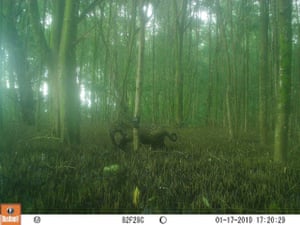
Oliveira said the jaguars have two fishing techniques – one is to wait for the tide to come in and to catch fish in the ponds that form among the mangroves, the other is to jump into the sea. “I’m not aware of any other jaguar population that eats so much fish – it’s very unusual,” he added.
The 600 sq km (230 sq mile) island – which is protected by the International Union for Conservation of Nature (IUCN) – has no human residents and animals have little contact with people. It has a diverse landscape of tropical forests, flooded grasslands, dense coastal mangroves and mudflats.
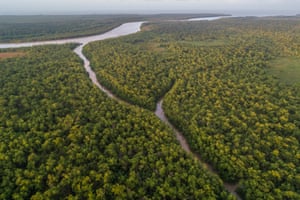
It is also a stop-off point for a number of migratory birds, including American flamingos, osprey and cuckoos. Fishermen say they have seen jaguars – as well as deer, anteaters and buffalo – swimming between the island and mainland.
There are 27 jaguars on the island and five to six cats per 100 sq km in some parts. Normally only two to five jaguars would share a territory of this size. The island’s jaguars are believed to hunt deer, buffalo, lizards and monkeys, but a plentiful supply of fish could be the secret to their success, researchers say.
Iranildo Coutinho, head of the ecological station on the island, describes it as a “kind of nursery or sanctuary” for jaguars because it may be fuelling populations on the mainland. “The fishermen often say that the island produces jaguars. It is the only coastal island along the coast of the Amazon and this is why it holds very important samples of fauna and coastal vegetation that are very well preserved and act almost like a live laboratory,” he said.

The area of mainland adjacent to the island is dangerous for jaguars as there are several buffalo farmers who feel threatened by the presence of the cats. At the end of 2018, a female jaguar was killed with her cub after attacking dogs in the village of Sucuriju, 30 miles (50km) from the island.
Jaguars are near threatened according to the IUCN red list, with sharp declines caused by deforestation and the illegal wildlife trade, which targets them for their skin and body parts.
The Amazon is the single largest remaining stronghold for jaguars, but it is estimated recent wildfires have destroyed the habitats of 500 individuals. These cats are one of the largest predators in South America and are often seen as a litmus test for forest health.

The satellite technology fitted to the collars of the jaguars on Maracá-Jipioca provides researchers with hourly updates on the animals’ movements. The camera traps have already taken more than 30,000 pictures. Understanding how a predator uses its territory will help researchers learn how to limit inevitable conflicts with humans.
WWF conservationists also collected blood samples from the collared jaguars to work out if they are crossing onto the mainland to breed – if not, then they are likely to have a very small gene pool, which could pose a problem for the long-term health of the population.
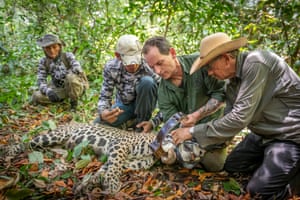


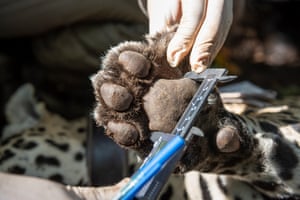
Dr Chris Carbone, a senior research fellow at the Zoological Society of London who is an expert on predator-prey relationships, said the research (in which he was not involved) shows how versatile these cats are. “It is good to see jaguars showing such adaptability, as wildlife in general are increasingly exposed to reductions in their habitats and this ability to adapt may be critical for the future survival of such populations,” he said.
“That said, we shouldn’t be complacent. We don’t know how long jaguars have been fishing on these islands. If it is a long-standing behavioural adaptation, it may be that many species are experiencing changes in their habitats which are too sudden to allow for them to adapt.”
The research is being carried out in collaboration with the Jaguar Conservation Fund and Chico Mendes Institute for Biodiversity Conservation. Jaguar conservationist Lailson Ferreira, who works with WWF on the island, said: “It’s important to preserve this island because this place is a treasure. There are very special creatures here, like the spotted jaguar and many others.”
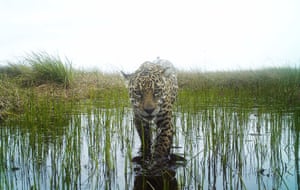
Oliveira added: “Months of meticulous planning went into the mission, but we can never guarantee collaring a wild animal. To have collared three jaguars on this first WWF expedition is an amazing result.
“The satellite technology fitted to the collars is providing us with hourly updates on the animals’ movements for up to eight months, resulting in a bank of information on how the jaguars use the forest to live and flourish.”
Next year, researchers are setting up more camera traps and in June 2020 they will collar two more jaguars.









